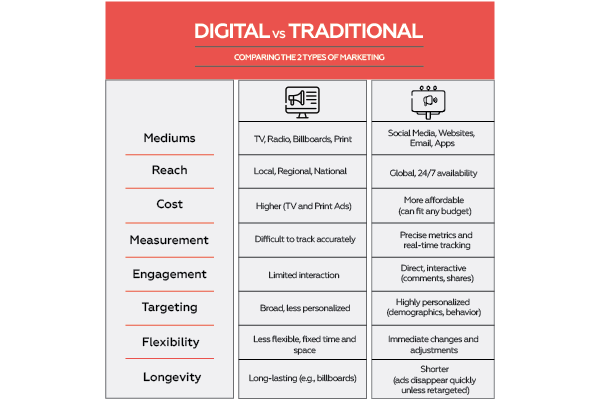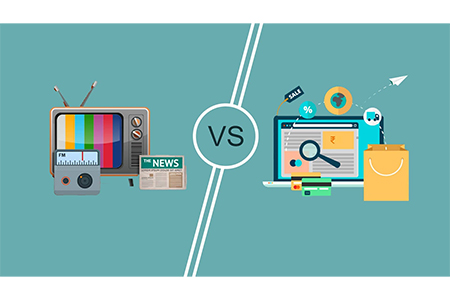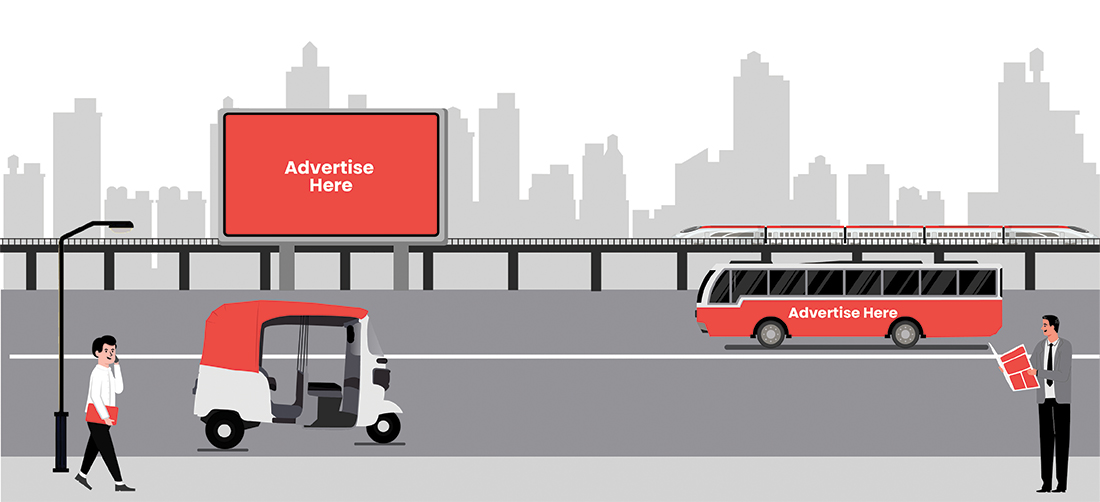Table Of Content
- 1. Traditional Advertising
- 2. Types of Traditional Advertising
- 2.1. Print Advertising
- 2.2. Broadcast Advertising
- 2.3. Outdoor Advertising
- 3. Benefits of Traditional Advertising
- 3.1. Broad Reach
- 3.2. Tangibility and Credibility
- 3.3. Established Trust
- 4. Challenges of Traditional Advertising
- 4.1. Cost Considerations
- 4.2. Measurement Difficulties
- 4.3. Limited Targeting
- 5. Traditional Advertising vs. Digital Advertising
- 5.1. Comparison of Effectiveness
- 5.2. Audience Engagement
- 5.3. Integration Strategies
- 6. The Role of Traditional Advertising in Modern Marketing
- 7. Conclusion

Imagine walking down a busy street, and a giant billboard with bold colors catches your eye, or you’re flipping through a magazine, and a glossy perfume ad almost makes you feel the scent. That’s traditional advertising at work - grabbing your attention in places you didn’t expect but can’t ignore.
Traditional Advertising
Traditional advertising represents the age-old methods used by brands for decades in order to reach the target audience. Before the Internet, businesses were still communicating with their target customers through printed pages, screens on TV, radios, and billboards. These methods helped companies find a voice to tell stories about themselves and build brand loyalty. From print advertisements in the 1800s to television and radio, traditional advertising forms have passed through the years and are always among the most reliable methods of reaching a message to people at different stages of their lives.
Types of Traditional Advertising
Print Advertising

Print advertising refers to print ads in newspapers, magazines, or brochures. This form is appreciated for having a tactile touch - something one can hold and engage with. For example, newspapers enable businesses to reach local readers; therefore, it is well suited for smaller businesses or events. Magazines permit brands to access particular demographics based on what their readers are interested in, such as fashion or technology. A beautiful visual as well as the opportunity for space to create a lengthier message will really make a print ad leave one with a lasting impression.
Broadcast Advertising

Broadcast advertisements vary from television and radio to the application of storytelling, where millions are reached when a TV advertisement is strategically placed during a popular television show. These advertisements utilize the use of visuals, sound, and music to illustrate stories that remain inside the heads of the audiences hence attaching them emotionally. Radio advertisements, however, though in limited audio only can be as catchy with amusing jingles or smartly written scripts in order to capture attention over a few seconds.
Outdoor Advertising

Outdoor advertising includes hoardings, billboards, and transit ads that are placed in such a way as to capture high-traffic routes. The big, bold display is impossible to miss, and the message or headline reaches the reader's mind within seconds. Billboards, for example, give high visibility and, if structured correctly, become landmarks of themselves. Outdoor ads need creativity and impact, as attention needs to be captured in a flash, be it through humor, bolder visuals, or a memorable tagline.
Traditional advertising might not be new, but its power to surprise, engage, and leave a mark is timeless.
Benefits of Traditional Advertising
Broad Reach
Traditional advertisements in the form of TV, radio, or print ads can reach a wide mass within a short period of time. A single ad on a popular channel can connect millions of potential customers to your brand across all age groups and locations. This makes it a good choice for brand awareness because it gets the word out to a broad pool of people all at one time.
Tangibility and Credibility
One significant positive advantage of traditional advertising is its tangibility. It's a billboard, a magazine ad, or a flyer that people can hold, touch, and see. Tangibility gives a kind of trust that digital advertisements do not enjoy. It's simply that people believe more what is printed out because of a feeling they have that these materials somehow have life in them and are less fluid than any online ad that moves so fast that it might be completely skipped or will be overlooked in an instant.
Established Trust
Traditional advertisement has been there for decades. Therefore, it has developed quite a lot of reliability over the years. Consumers follow these advertisements on TV and newspapers. Brands are more associated with good and known brands in such advertisement media. With the passing of time, this builds trust for the brand among its customers.
Traditional ads also relate to the sentimental value of the older generation, thereby creating strong sentiments attached to the brands.
Challenges of Traditional Advertising
Cost Considerations

Traditional advertisements, including television ads and print ads, can be very expensive. It poses a problem for small business firms because the costs of producing and placing traditional advertisements are quite high and smaller budgets cannot compete with that of bigger companies.
In addition, firms typically pay for the ad spots in advance, often without knowing how effective they will be. There's a higher financial risk with this. Small businesses may not get a return on their investment from ads like these.
Measurement Difficulties

Traditional advertising has a significant problem: it can't measure its effectiveness very well. A print or a TV ad does not make a person track who sees an ad and what that person does afterward.
Unlike digital ads where people can track views, clicks, and conversions, traditional does not offer that level of insight. Not being able to know if an ad campaign is worth money spent, makes it extremely challenging.
Limited Targeting

The biggest drawback of traditional advertising is perhaps that it covers a large audience. Traditional advertisements air on television and radio and are broadcast to absolutely anybody, without concern as to whether they would be interested in the product or service.
This non-targeted approach leads companies to pay money to reach the wrong people who are not prospective customers. With digital ads, targeted messaging can zero in on locations, interests, and online behavior, meaning it's more efficient and cost-effective.
Traditional Advertising vs. Digital Advertising

Comparison of Effectiveness

Traditional advertising still boasts a lot of grounds in many areas, especially in reach. This is because most people are reached by television, radio, and print advertisements. On the other hand, digital advertising has exploded lately with companies like social media, search engines, and websites. As such, these can reach a specific demographic.
It reached more than $500 billion in 2023 according to Statista's study, whereas traditional media ad spending is continuously decreasing. Digital ads are much more measurable and allow immediate adjustments in a campaign, making digital ads very attractive for businesses seeking accurate control of their campaigns. Traditional advertising would offer broad but less-targeted coverage.
Audience Engagement
Interaction between the audience and advertising has also undergone significant shifts. Methods like traditional TV or print are considered passive - viewers or readers are recipients of the message, having little to no interaction. They absorb information, but their ability to respond is very minimal, usually using what one usually finds in such advertisements: a phone number or a website.
Digital advertising is more dynamic because it is interactive. What social media has done to an advertisement, for example, is allow its users to comment, share, and like thereby creating a different relationship between brands and consumers. This interactivity then makes them engage deeper since they feel more in control of what they view. In addition, digital ads can be personalized by their behavior toward the users, thus increasing their relevance and chances of interaction.
Integration Strategies
There is no longer a need to choose between traditional and digital advertising because they can now be put together in a single strategy. Combining the scope of reach of traditional media with the precision of reach of digital will add depth to a marketing campaign. For instance, a TV ad may let viewers find their company's social media profile or website with further content specific to their interest. Print ads can also carry QR codes or links that users can scan or click for direct access to online promotions. This method, therefore, encourages the target audiences to act immediately.
A proper integration strategy weighs the benefits of one another method of advertising. For instance, traditional media facilitates the establishment of client trust and brand awareness, whereas digital vehicles are likely to enhance customer interest and ensure returns on every investment. As such, by using both tools, companies can reach a larger population and make a stronger impact on their marketing campaigns.
The Role of Traditional Advertising in Modern Marketing

In an increasingly screen-based world, traditional advertising still seems to be at its best, and here's why: it's just like that old friend who refuses to get old. Newspaper Advertising, Radio Advertising, Television Advertising, and Magazine Advertisement seem old-fashioned, but they touch people in ways online ads can't. With all this scrolling around on their phones, these classic ads appear simple yet draw attention on a large scale.
Traditional advertising methods also play a huge role in rounding out the marketing circle. Just think about that hook radio ad telling you to look up that brand's Instagram, or that billboard that sparks curiosity about some new product that you then track down online. It is the seamless integration of old and new that speaks more to consumers at a deeper level.
Of course, we forget that nothing compares to the tried and true in this age of the digital behemoth. After all, there is something about traditional ads that seems more personal and trustworthy; they are certainly not fighting for attention like digital is. It's a choice between both - making one bigger and bolder. Advertising, after all, is not dying - it’s thriving, rather - when it comes to modern marketing.
Conclusion
For most brands seeking universal recognition, traditional advertising is still one of the forceful methods of getting the message through. While it's true that the digital landscape is changing in leaps and bounds, the fact remains that for millions of people, traditional advertising works through their favorite TV, radio, and print products.
A great traditional advertising example is the use of billboards in high-traffic areas, which consistently draw attention and reinforce brand presence. For businesses looking to make a significant impact, blending traditional and digital advertising offers the best of both worlds - wide reach and targeted engagement. However, it’s crucial to work with the right advertising agency to create successful campaigns. That’s where Excellent Publicity comes in. With years of proven experience and a talented team, our advertising agency specializes in delivering top-notch traditional advertising strategies that help brands stand out.
Contact Excellent Publicity to elevate your brand to new heights.
FAQs
Traditional advertising refers to marketing techniques that have been in use for several decades, the list of which includes TV ads, radio ads, print ads in newspapers and magazines, and boards on the streets. All these forms focus on reaching a wide audience through means of either physical or broadcast media.
In comparison, the classical forms of advertisement make use of physical media or broadcasting channels such as television and radio. Instead, the digital form of advertisement makes use of the internet, social networks, and search engines. The campaigns offered by digital advertising are more specific, measurable, and interactive than those of traditional advertising, which tend to focus on a larger, less targeted target audience.
Examples of traditional advertising, include TV commercials, radio spots, print ads in newspapers and magazines, billboards, flyers, and direct mail. All the above are one-way communications involving no instantaneous feedback from the receiver.
Traditional forms of advertising reach a wide, mixed group of people, especially those who are not keen on the Internet. It also lends itself to brand recall through repetition in established media, such as television or print. Traditional advertising also creates a more realistic connection with the consumer in its print format.
Yes, traditional advertising is still alive to a certain extent, especially if there are specific target demographics that are not actively visible on the net. It completes and supplements digital strategy since businesses are dealing with multiple audiences and ensuring brand presence in nearly all kinds of media channels.



